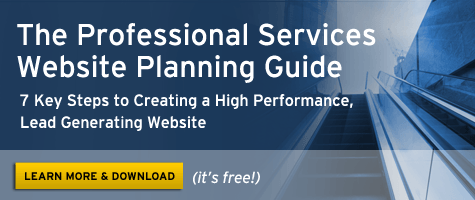More and more professional services firms are developing and launching lead generation websites. Key drivers behind this shift in marketing include the following:
- Online marketing and especially websites are data driven and easily measured
- Once you launch a website it is always working for you and generating leads
- There have been major shifts in the way people look for new service providers
So what are the must have components of a lead-generation website? Below are my five top picks.
- Optimized for search engines (SEO) Even if evert other component described below is executed perfectly your website won’t start generating leads until people find it. This makes SEO a vital piece of the lead generation puzzle. Optimizing your website for relevant keywords is crucial to its success as a lead-generation engine.
- A consistently updated blogPosting regularly to your blog is important for two reasons. First, every blog post can be indexed by Google. This means that every post you write has a chance to rank well in Google and drive quality traffic to your site. Second, blogs are a great way to educated your web visitors and begin to build trust. Increasingly, the internet is becoming the preferred way to find educational material. If the material you post is useful and interesting, your blog can become a trusted resource for people who might one day need your services.
- Downloadable contentOnce visitors are on your website and reading your blog, there’s a good chance that some of them will want even more information. Publisihing longer-format content is a way you can fulfill this need and keep readers enganged and turn them into leads. Content can take many forms: ebooks, guides, kits, webinars, to name just a few. Most people will be willing to exchange a small amount of personal information — such as their name and email address — for in-depth content. So be sure to put your most valuable content peices behind a basic registration form. Just keep in mind that the more information you require, the less likely people will be to fill out the form. Then use the email addresses you collect to nurture these people with additional content and offers — until one day they are ready to buy services.
- Sidebar offersSidebar offers are the key to getting web visitors to take action. Promote your most valuable content in the sidebars of your web pages. And don’t forget to include some hard offers, too — such as free consultations or “request a proposal.” Link all of these offers to forms. This exchange opens the communication channels for future marketing.
- AnalyticsThe final essential piece of a lead generation website is analytics. Set up an analytics package (Google Analytics is popular free option) to track what is happening on your site and which offers are leading to form fills. You’ll also want to keep an eye on which keywords are driving traffic to your site from search engines. Then consider developing content that is relevant to people who search on your most popular keywords. Analytics will even tell you what keywords are driving the most conversions so you can begin optimizing for related keywords. Tracking your website traffic allows you to determine the ROI on your investment and make quick adjustments to your strategy.
Sure, there are other components to lead generation websites, but these are the most important ones. Implement these strategies, and you will be generating high-quality traffic and leads before you know it.

